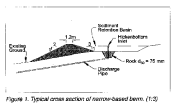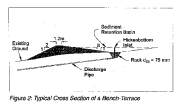Water and sediment control basins are used as a method to minimize soil erosion. They are effective in preventing bank and gully erosion by collecting and storing sediment along with other waterborne debris. Generally, they prevent downstream erosion that can result from concentrated flows. Sediment control basins are recognized as an effective Best Management Practice to enhance and improve water quality. They are often referred to as "bench-terraces" or "floodwater storages for smaller drainage areas".
Water and sediment control basins consist of a berm, a ponding area and a pipe or tile outlet. The berm is constructed across the slope of the land to provide a temporary storage area for the surface runoff. Soil is piled and used to direct water to a stabilized location.
The ponded water is slowly discharged through an underground outlet system. This eliminates erosive actions occurring further down the slope and prevents damage to crop or other vegetation. A grassed waterway, diversion or drop inlet may also be used in combination with the water and sediment control basin as an effective soil conservation system.
The ponding process slows the water flow, allowing sediment and debris to settle out before it reaches the drop inlet. The larger the storage basin the more time available to enhance the proportion of settled sediment. This prevents the undesirable deposition of silt on low lands or critical areas. Water and sediment control basins reduce pollution by collecting silt, fine sand, wastes and other debris.


